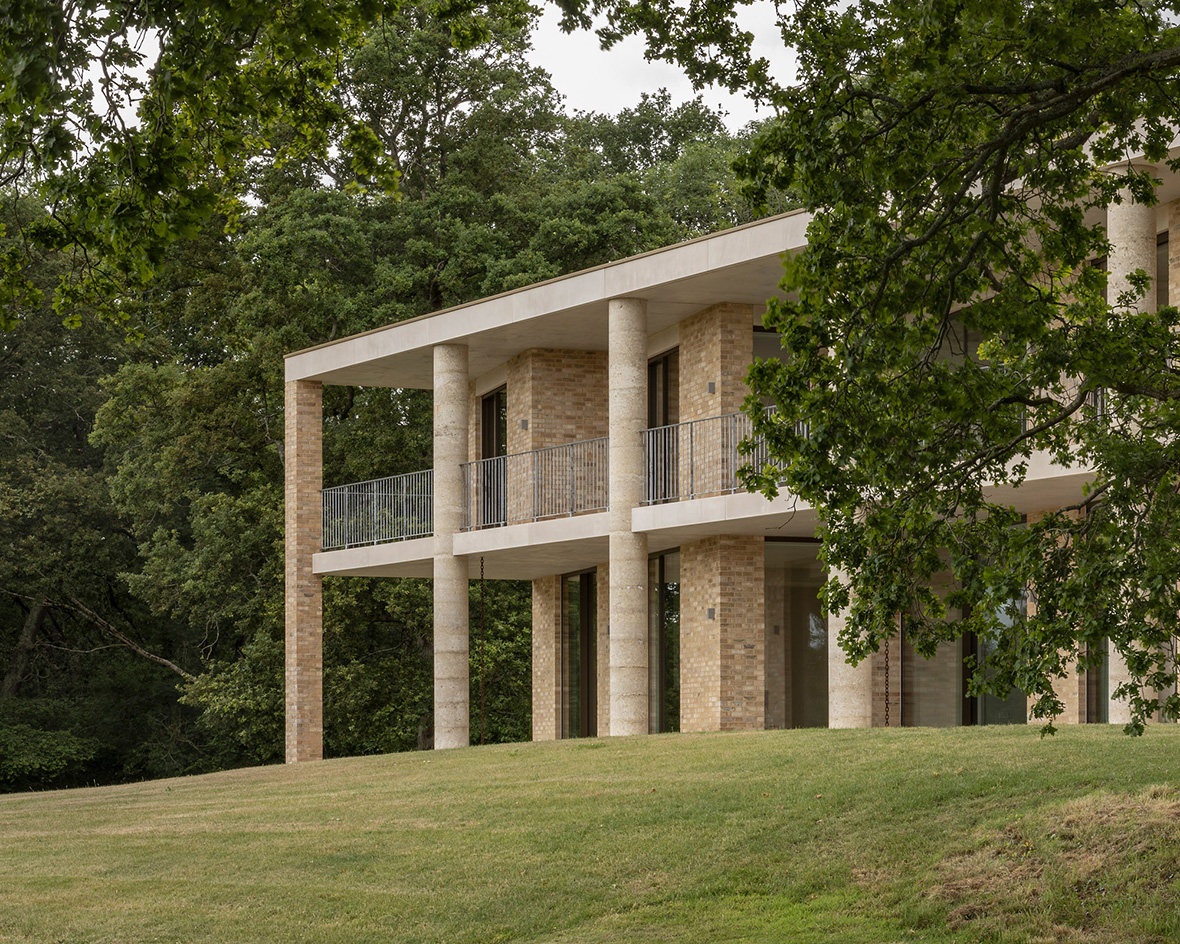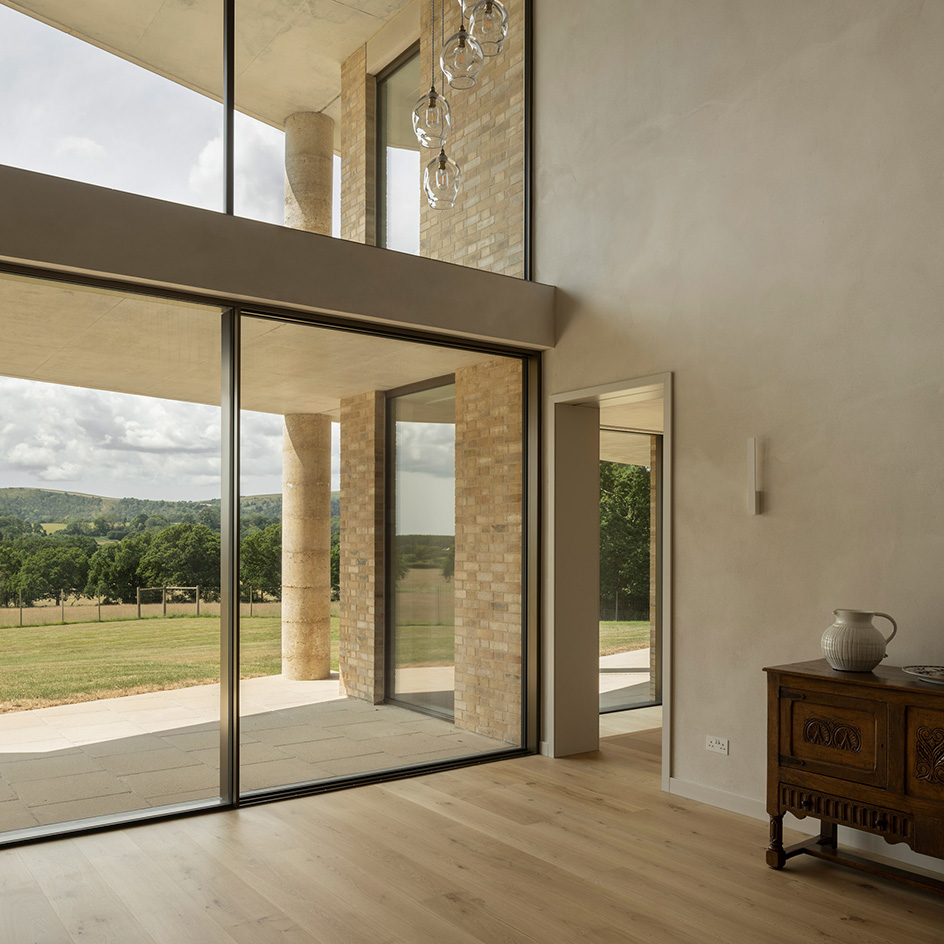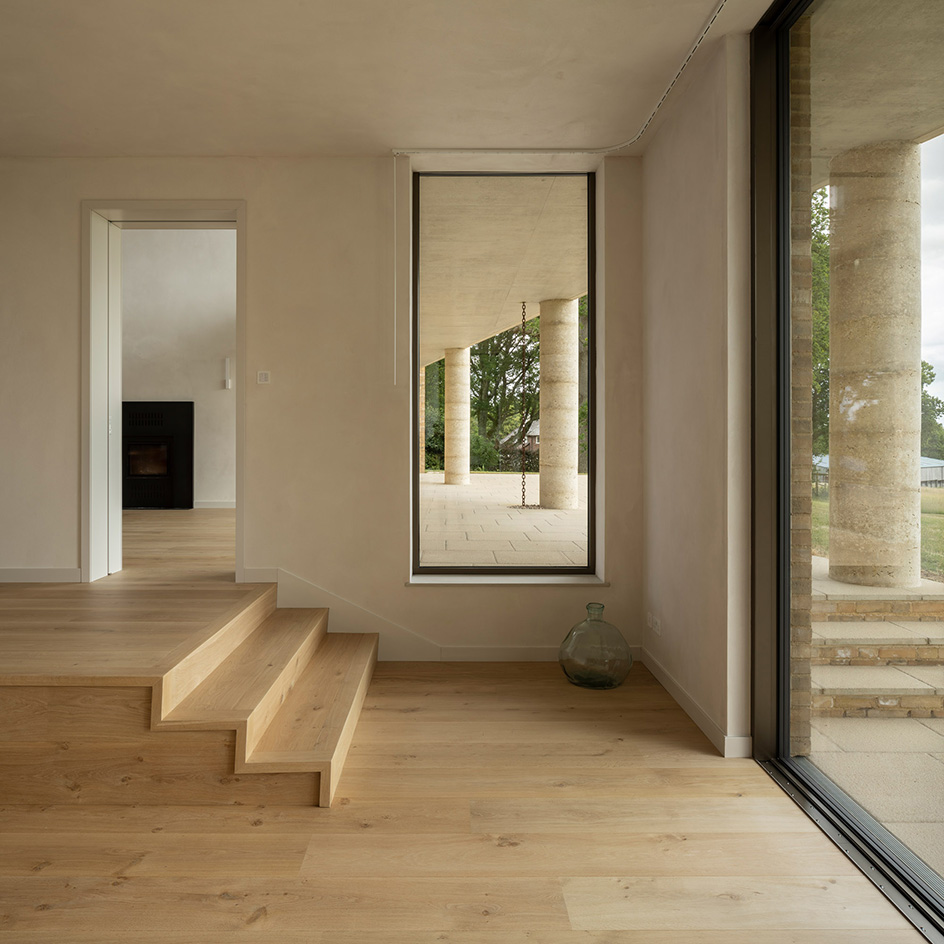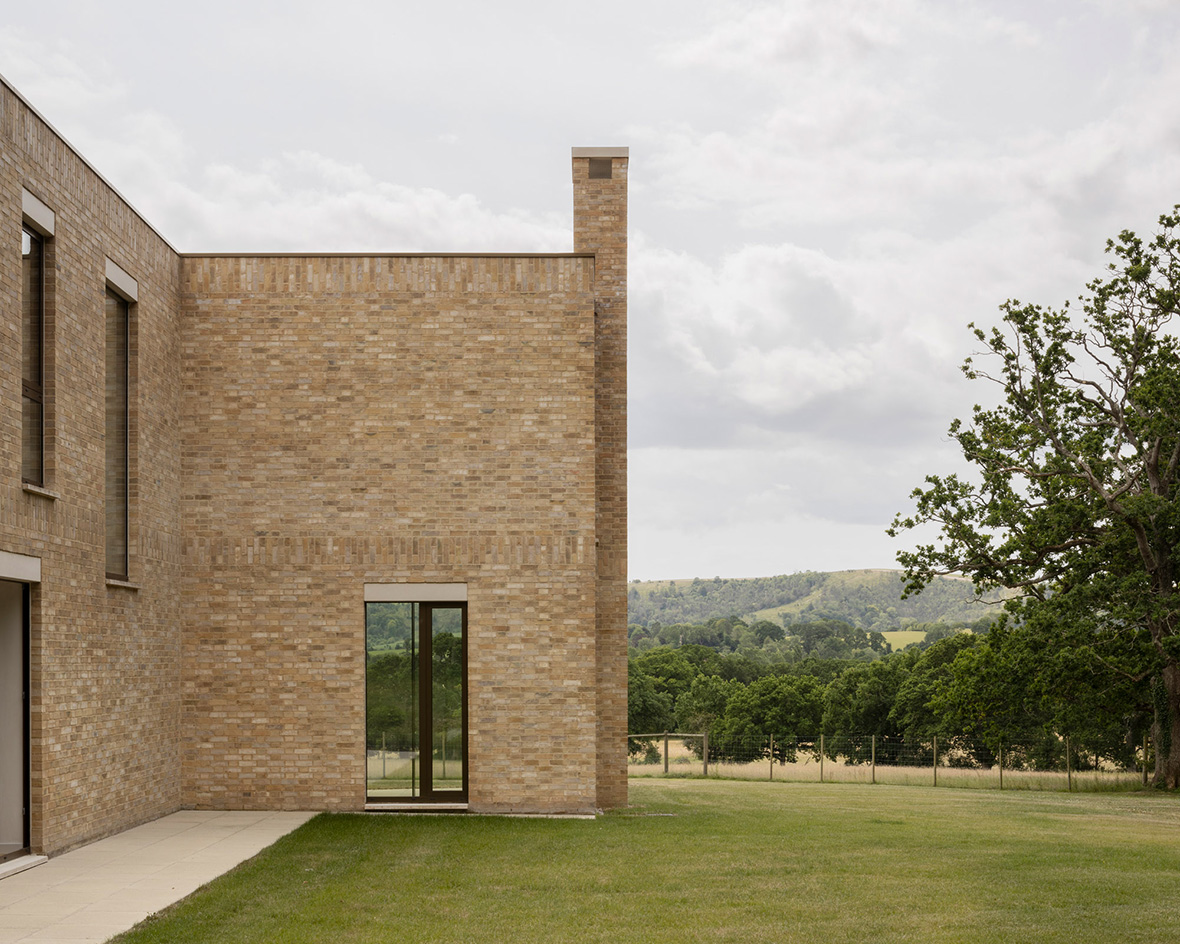This South Downs house stands as a testament to the value of quiet refinement
At one with the landscape, a South Downs house uses elements of quintessential country villas and midcentury gems with modern technologies

This South Downs house, occupying a glorious position that overlooks the rolling hills of the National Park in South England, was designed by Sandy Rendel Architects and is a testament to the value of careful, quiet refinement. Set on a gently sloping plot in West Sussex, the residence presents an almost neoclassical face to the world.
‘In a way, it was hard to go wrong with the site,’ says Rendel, ‘’We just had to reveal the landscape to the building – the weather patterns and light are constantly changing.’ The most dominant feature is a series of five thick columns that march across the south façade. Formed from concrete and aggregate made from locally quarried Fittleworth stone, the rammed columns form striated, solid structural components that anchor the house and frame the views.

A South Downs house in tune with its site
It wasn’t a straightforward project, not least because the build process spanned the pandemic. And anyway, interesting architecture rarely is, such are the vagaries of clients, planners and contractors, and all the myriad complexities involved in creating a truly bespoke structure. However, Rendel’s small London-based firm is adept at making the most of a challenge. Capable of eking generous living spaces out of unpromising locations (the compact Slot House in south London, designed in collaboration with his wife Sally, was shortlisted for the 2021 RIBA House of the Year), the studio can also build at scale, without losing sight of craft and detail. Their much-garlanded house in Lewes, East Sussex, ran the gamut of design exposure, including an RIBA National Award, demonstrating an aptitude for material innovation and respect for the site.
It was this latter project that caught the eye of Rendel’s new clients. They had already acquired the site with its existing bungalow and secured planning permission for a much larger house, designed in the area’s ubiquitous neo-vernacular. Then came a chance encounter with the Lewes house. A new direction was desired. Seven years ago, Rendel was hired and the project began.
But, despite the new design being substantially smaller than the existing planning permission, the planners rejected it, and it wasn’t until a design review panel gave it the thumbs up that the planners acquiesced. ‘There’s a history of country houses with their own parkland around here,’ says Rendel. ‘The heavy clay soil isn’t quite so fertile in this area, so traditionally it was more about recreation, not agriculture.’

Based around a structural concrete frame that includes those rammed columns, the project, which took five years to complete, extends across two storeys and a generous 459 sq m, with additional space in a separate annexe/guest bedroom. The columns support a first-floor balcony running the length of the south façade, which, in turn, shields a covered patio accessible from the reception rooms, all of which look out at the unbroken view. The colonnade faces due south, but the plan itself is canted at a slight angle, with the difference creating the covered space and first-floor balcony. The glazing is therefore set back, creating useful solar shading in the summer and a wall that kinks back and forth to give different aspects to the bedrooms, along with little niches that are tucked away from the prevailing winds on the terrace.
The new house is like the quintessential parkland villa, with its sweeping drive, grand outlook and distinguished presence from a distance. Parking and services face a rear yard, tucked away from the main house, another reference to traditional country house layouts. Rendel acknowledges the influence of an early 20th century precedent, the architect Serge Chermayeff’s own house, Bentley Wood, completed in 1938 in neighbouring East Sussex, as well as Swedish firm Tham & Videgård Arkitekter’s 2014 Archipelago House in Stockholm. Like these examples, the South Downs house blends formal language with subtle disruption, giving equal weight to views from within and outside, without compromise.
Receive our daily digest of inspiration, escapism and design stories from around the world direct to your inbox.
Although the concrete frame is left exposed, the combination of yellowish-brown buff bricks gives warmth, helping to ground the house in the landscape. The single-storey annexe and garage have meadow roofs, another layer of planting that breaks up the brick walls, which are themselves arranged as a series of distinct volumes, with large frameless glazing and tall chimneys rising above the parapet level.

The ground floor contains a living room and snug along with a kitchen and utility area, all arranged around the double-height dining space. The staircase is pushed to the side of the plan, making space for a generous first-floor landing. Upstairs, three of the bedrooms look out across the balcony to the view, with two more suites located at the rear of the plan. The interior is precisely detailed and carefully finished, with lime plaster walls juxtaposed with exposed concrete framing on the ceiling and wooden floors.
Together with project architect Sophie Roycroft, Rendel led a huge amount of research and development that went into every facet of the project. As a result, design details are ingenious, forms are precise, and the very best solution has been carefully and meticulously arrived at. For example, the single wood-burning stove is also plumbed into the hot water and underfloor heating, and can run the entire house if necessary. The house is also extremely energy efficient. With a rooftop photovoltaic system and an air-source heat pump, it generally generates more energy than it consumes. ‘As the project progressed, it became obvious that some technologies had improved enormously,’ says Rendel, pointing out that air-source heat pumps are easier to install and maintain than ground-source versions, with practically the same levels of efficiency.
Rendel and his team have set a high standard for contemporary rural design, emphasising the importance of proportion, scale, craft and materials. Seen against a backdrop of mature trees, with soft landscaping by Euphorbia Design gradually bedding in, this house truly feels at one with the landscape.
Jonathan Bell has written for Wallpaper* magazine since 1999, covering everything from architecture and transport design to books, tech and graphic design. He is now the magazine’s Transport and Technology Editor. Jonathan has written and edited 15 books, including Concept Car Design, 21st Century House, and The New Modern House. He is also the host of Wallpaper’s first podcast.
-
 Inside Christian de Portzamparc’s showstopping House of Dior Beijing: ‘sculptural, structural, alive’
Inside Christian de Portzamparc’s showstopping House of Dior Beijing: ‘sculptural, structural, alive’Daven Wu travels to Beijing to discover Dior’s dramatic new store, a vast temple to fashion that translates haute couture into architectural form
-
 A music player for the mindful, Sleevenote shuns streaming in favour of focused listening
A music player for the mindful, Sleevenote shuns streaming in favour of focused listeningDevised by musician Tom Vek, Sleevenote is a new music player that places artist intent and the lost art of record collecting at the forefront of the experience
-
 Take a tour of the 'architectural kingdom' of Japan
Take a tour of the 'architectural kingdom' of JapanJapan's Seto Inland Sea offers some of the finest architecture in the country – we tour its rich selection of contemporary buildings by some of the industry's biggest names
-
 Arbour House is a north London home that lies low but punches high
Arbour House is a north London home that lies low but punches highArbour House by Andrei Saltykov is a low-lying Crouch End home with a striking roof structure that sets it apart
-
 A former agricultural building is transformed into a minimal rural home by Bindloss Dawes
A former agricultural building is transformed into a minimal rural home by Bindloss DawesZero-carbon design meets adaptive re-use in the Tractor Shed, a stripped-back house in a country village by Somerset architects Bindloss Dawes
-
 RIBA House of the Year 2025 is a ‘rare mixture of sensitivity and boldness’
RIBA House of the Year 2025 is a ‘rare mixture of sensitivity and boldness’Topping the list of seven shortlisted homes, Izat Arundell’s Hebridean self-build – named Caochan na Creige – is announced as the RIBA House of the Year 2025
-
 In addition to brutalist buildings, Alison Smithson designed some of the most creative Christmas cards we've seen
In addition to brutalist buildings, Alison Smithson designed some of the most creative Christmas cards we've seenThe architect’s collection of season’s greetings is on show at the Roca London Gallery, just in time for the holidays
-
 In South Wales, a remote coastal farmhouse flaunts its modern revamp, primed for hosting
In South Wales, a remote coastal farmhouse flaunts its modern revamp, primed for hostingA farmhouse perched on the Gower Peninsula, Delfyd Farm reveals its ground-floor refresh by architecture studio Rural Office, which created a cosy home with breathtaking views
-
 A revived public space in Aberdeen is named Scotland’s building of the year
A revived public space in Aberdeen is named Scotland’s building of the yearAberdeen's Union Terrace Gardens by Stallan-Brand Architecture + Design and LDA Design wins the 2025 Andrew Doolan Best Building in Scotland Award
-
 A refreshed 1950s apartment in East London allows for moments of discovery
A refreshed 1950s apartment in East London allows for moments of discoveryWith this 1950s apartment redesign, London-based architects Studio Naama wanted to create a residence which reflects the fun and individual nature of the clients
-
 In this Cotswolds home, drama meets minimalism
In this Cotswolds home, drama meets minimalismCotswolds home Hiaven house, with interiors designed by McLaren Excell, is a perfect blend of contemporary chic and calm, countryside drama